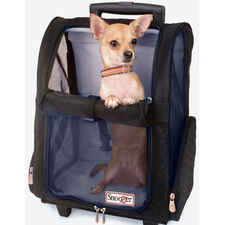Pet Carriers for Travel and Everyday Use
Doctor of Veterinary Medicine

While efforts are made to answer all questions as quickly as possible, if an immediate answer is required or if your pet is in need of urgent or emergency care, contact your pet's veterinarian immediately.
Doctor of Veterinary Medicine

You will receive an answer from Dr. Lindsay and our vet/tech team as soon as possible, usually the same day.
All answers are provided for informational or educational purposes only, and are intended to be a supplement to, and not a substitute for, the expertise and professional judgment of your pet's veterinarian.
It may be necessary to consult your pet's veterinarian regarding the applicability of any opinions or recommendations with respect to your pet's symptoms or medical condition.
CloseDoctor of Veterinary Medicine

An error has occurred, please reload the page and try again.
CloseWhile efforts are made to answer all questions as quickly as possible, if an immediate answer is required or if your pet is in need of urgent or emergency care, contact your pet's veterinarian immediately.
There is no answer related to your question
Traveling with your pet does not have to be difficult. Choose a pet carrier to help you transport your furry friend in comfort and convenience. Pet carriers are a great way to help your pet arrive safely at your destination and can also be used for everyday trips. While some pet carriers can be stylish, safety is one of the main things you should have in mind when purchasing a carrier for your pet. There are a variety of carriers to choose from depending on the size of your pet and the distance you are traveling.
If traveling by air, please always check your airline's specific pet carrier requirements, as they can vary.
Carry-on carriers
If you have a small pet, you may prefer to use a carry-on carrier to take your four-legged friend on board with you. These carriers come in either a soft or plastic (hard shell) material and are meant to go under the seat in front of you.
Please note: It is always best to call your airline to make sure that traveling with your pet in the carrier is permitted on the airline. Some airlines charge extra fees for traveling with your pet and some have a limit on how many pets can fly in the cabin at one time. This varies on all the different airlines. We recommend checking with the airline at least two weeks in advance for their specific rules and requirements.
Cargo carriers
Your larger pet will probably have to travel in the cargo area of the plane. Hard cover carriers are generally made of a plastic shell that makes them more durable than soft pet carriers. Pet cargo carriers are generally made of this type of material since it helps keep your pet safe and secure for the duration of the flight. Consider placing a soft pad or pillow inside the carrier to help your pet feel more comfortable.
Soft pet carriers
Fabric pet carriers are soft and pliable, which generally make them easier to carry with you.
Hard shell pet carriers
Hard shell pet carriers can be used for airline travel, transporting larger pets to the veterinarian by car, or just visiting family and friends. Some also function as crates for housebreaking your pet.
Designer pet carriers
Some carriers may also be used as a personal bag (for on-the-go pet owners who like to travel in style). These type of pet carriers have dual functionality. Made to transport your small pet and also work as a purse, designer carriers have convenient side or interior pockets to store a wallet or other small items. On some airlines, they can also be used as airline carry-on. Always check your airline's specific requirements.
To ensure you order the right size dog carrier, measure your dog's height and width, and also keep in mind how large he or she will be when full grown. Doing so will ensure your dog has enough room to move around in the carrier.
 Swipe
Swipe






















